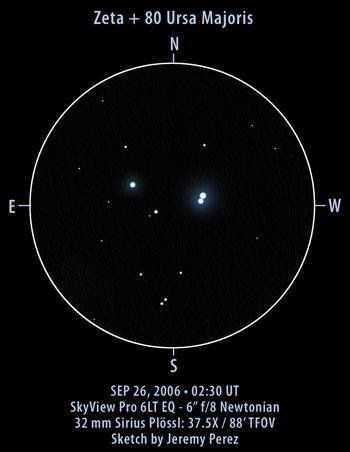Double Star of the Month:
Zeta Ursae Majoris
AKA: Mizar, STF 1744. Position: 13 hr 23.9 min 54 55 31.
Due south at 22.49 (BST) on 15 May 2020.
Image credit: Jeremy Perez (http://www.perezmedia.net/beltofvenus)
Used with permission
What is the brightest double star? The short answer is the brightest star, Sirius, but as I discussed in Star of the Month for February 2020, Sirius B is much fainter and is not easy to see in a small telescope. But what is the brightest double star if we take both components into account? In other words, which double star has the lowest combined magnitude? The answer—which may surprise you—is Zeta Ursae Majoris. And you might think that you have never heard of Zeta Ursae Majoris, but you will almost certainly have come across Mizar and Alcor. Mizar and Alcor are interesting for another reason as well; they are so widely separated that most observers can separate them with the naked eye.
This in turn raises two more questions. What is the widest double and what is the smallest gap that the human eye can resolve? The first question is practically unanswerable. The Washington Double Star Database has an arbitrary cut-off at 999.99 arcseconds (16 2/3rds arcminutes) but there are many double stars which are wider than that. The resolution of the human eye is a function of the size of the human eyeball and the photoreceptors at the back of the retina. In practice under laboratory conditions it can range between 40 and 60 arcseconds (in other words, slightly less than one arcminute). This means that at least in principle many of the wider double stars should be resolvable by the naked eye.
The problem is not the separation, but the brightness of the secondary. If the secondary is much less bright than the primary, it would be more difficult to see with the naked eye even if it was a single star and crucially it can be hidden by the glare of its bright primary even if it is a naked eye star. Dabih (Beta Capricorni) which is just above Saturn in the morning sky at the moment has a good separation of 205 arcseconds, but the secondary is only magnitude 6.1—easy to separate with binoculars or a small telescope but not with the naked eye. There are a few double stars which are both wide enough and bright enough to be resolved with the naked eye at least in dark skies. To mention just four, there are the famous Epsilon Lyrae in Lyra (to be covered in a later DSotM), Mu Scorpii and Zeta Scorpii in Scorpius which suffer from being low in the sky, and Algedi (Alpha Capricorni) in Capricornus above Dabih. By far the brightest (in terms of both its components at 2.2 and 4.0) and in terms of separation (at 11.8 arcminutes – technically twelve times the human limit) is Mizar and Alcor. I have to say, though, that they lie at the very edge of my own perception.
However Mizar is not just a wide double with Alcor, it is also a tight double with another star which remarkably is almost the same magnitude as Alcor (3.9) and a separation of 14.4 arcseconds. In binoculars or a small telescope it is easy to see yet another star between Mizar and Alcor which is magnitude 7.6. As an easy naked eye double (especially in a dark sky), Alcor and Mizar were known to the medieval Arabs although whether they possessed the concept of a double star is debatable. Mizar itself was the first telescopic double discovered by Benedetto Castelli, a friend of Galileo, in 1617. Remarkably Mizar A was also the first spectroscopic double, discovered in 1889. Alcor is also a double. Mizar and Alcor are gravitationally connected (being part of the Ursa Major Moving Group), so together they form a sextuplet. The inbetween star was found by Johann Georg Liebknecht of Giessen University in 1722 (although it had been observed earlier by Castelli) who thought it was a planet and called it the Sidus Ludoviciana after his university and hence indirectly after Landgrave Ludwig V of Hesse-Darmstadt who had founded the university in 1607. It is not part of the Alcor-Mizar group. Mizar is easy to find being the second star in the handle of the Plough at the point where the handle bends to the right. It is readily confirmed by the presence of Alcor either with the naked eye, binoculars or the finderscope of a telescope. It is thus probably the easiest double to find in our skies. To my eyes they are all white, although Mizar B has been observed as being green or greenish.
